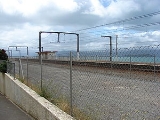
Ngauranga Railway Station
Encyclopedia
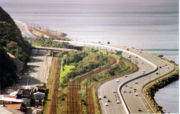
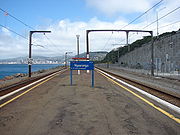
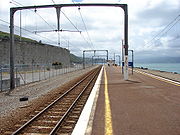
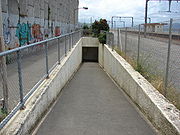
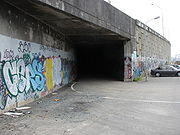
Island platform
An island platform is a station layout arrangement where a single platform is positioned between two tracks within a railway station, tram stop or transitway interchange...
railway station in the mainly industrial and commercial suburb of Ngauranga
Ngauranga
Ngauranga is a suburb of New Zealand's capital city, Wellington, in the lower North Island. Situated on the western bank of Wellington Harbour, it lies to the north of the centre of the city. It is a Maori name meaning "the landing place", and the original spelling was "Nga-Uranga"...
on the Wairarapa Line
Wairarapa Line
The Wairarapa Line is a secondary railway line in the south-east of the North Island of New Zealand, connecting the capital city of Wellington with the Wairarapa region. The line ends at Woodville, where it joins the Palmerston North - Gisborne Line...
in Wellington
Wellington
Wellington is the capital city and third most populous urban area of New Zealand, although it is likely to have surpassed Christchurch due to the exodus following the Canterbury Earthquake. It is at the southwestern tip of the North Island, between Cook Strait and the Rimutaka Range...
, New Zealand
New Zealand
New Zealand is an island country in the south-western Pacific Ocean comprising two main landmasses and numerous smaller islands. The country is situated some east of Australia across the Tasman Sea, and roughly south of the Pacific island nations of New Caledonia, Fiji, and Tonga...
. It is served by the trains of the Melling Line and Hutt Valley Line of the Wellington suburban rail network. Wairarapa Connection trains pass this station but do not stop. All trains are run by KiwiRail under the Tranz Metro
Tranz Metro
Tranz Metro, part of KiwiRail, is the operator of Metlink suburban trains owned by the Greater Wellington Regional Council in the Wellington Region of New Zealand....
brand as part of the Metlink
Public transport in Wellington
Public transport in Wellington, the capital of New Zealand, is well developed compared to other parts of the country. The system covers the Greater Wellington region, including Wellington city, Lower Hutt, Upper Hutt, Porirua, the Kapiti Coast and the Wairarapa.-Administration:Public transport in...
network.
Ngauranga formerly handled freight traffic, but is now used exclusively by commuter passenger trains. It is next to a waste disposal facility and at the bottom of the Ngauranga Gorge
Ngauranga Gorge
The Ngauranga Gorge is in the Wellington Region of New Zealand. State Highway 1 runs through the gorge, a vital link between Wellington City and the Kapiti Coast and the main route north out of Wellington. It is 2 kilometres long and has a grade of approximately 8%...
, next to the major road junction where State Highway 2 joins State Highway 1
State Highway 1 (New Zealand)
State Highway 1 is the longest and most significant road in the New Zealand roading network, running the length of both main islands. It appears on road maps as SH 1 and on road signs as a white number 1 on a red shield, but it has the official designations SH 1N in the North Island, SH 1S in the...
.
History
Though the rails of the Wairarapa Line reached Ngahauranga at New Year 1874, the first section of the line was not opened until 14 April 1874. Trains initially ran non-stop to the terminus of the line from Wellington, and it would not be until a week after opening, on 20 April, that Ngahauranga was included as a stop.Ngahauranga received its first building in late 1875. About 1879, the station received a class 6 passenger shelter costing £160. At the time, it had neither crossing loops nor sidings.
Livestock did not become a major source of traffic until the line reached Featherston in 1878, and was bolstered by the opening of the Wellington Meat Preserving and Refrigerating Company at Ngahauranga in 1884. To serve the abattoir, a siding was laid from the station yard across Hutt Road to the company’s works in June of that year. The company quickly became a significant customer for the railway, and in 1895 150,486 head of stock were railed to Ngahauranga. By about 1900, the station had stockyards and two sidings.
In the days of single-line working Ngahauranga was used to cross trains and in 1887 became one of the first stations in the region to receive new signalling equipment. Instructions issued for the crossing of trains specified that Down trains were to take the loop while Up trains were to use the main line.
Early in the 20th century it was decided to duplicate the line between Wellington and Lower Hutt. Preparatory work was started in 1903 with construction commencing the following year. The duplication reached Ngahauranga in 1908, but was not completed until three years later when it opened to all traffic on 4 April 1911.
The Wellington Meat Export Company, formed in 1881, operated an abattoir in the Ngauranga Gorge, and utilised the Ngauranga Industrial Siding to transport livestock in and carcasses out from the network of sidings in its own yard. The siding ran through a small tunnel under the motorway and crossed the Hutt Road to the works. The company operated the siding with a 20-ton Barclay 0-4-0ST until 1962, at which point it was replaced by a four-wheel diesel shunter. The siding was closed and removed in the 1980s, and the tunnel under the motorway is now used for vehicular access to the waste disposal facility.
In 1966 the construction of the new motorway into Wellington necessitated the realignment of the railway through Ngauranga. A new station was constructed on reclaimed land including the present-day station building, which replaced the much grander wooden structure of the old station. The motorway was built over the siding to the abattoir by constructing a tunnel for the siding.
In 1968 there was a reasonably extensive network of sidings at Ngauranga, including three lines on the western side of the station running parallel to the two main lines. The industrial siding to the abattoir connected with the station sidings at the southern end of the yard. The construction of the Ngauranga Flyover and motorway interchange in 1982 was the last major construction work in the vicinity of the station. Only the two main lines on either side of the island platform remain.
Services
Melling Line trains stop here every hour Monday to Friday, with daily half-hourly Hutt Valley Line trains supplemented at peak times. It is possible to transfer to buses to/from Johnsonville, Newlands or Churton Park at Ngauranga, to commute to the Hutt Valley without going into Wellington.Facilities
A station building on the platform provides shelter for waiting passengers. Access to the station is by a subway that connects via a short walkway to Hutt Road. No car parking is provided.External links
- Train timetables from Metlink and Tranz Metro.

